How To Grow Tangerine Trees In Arizona
Things Needed
- Fertilizer
- Mulch
- Pruning shears and loppers
- Tree paint
The tangerine (Citrus x tangerina) is a smaller and sweeter variety of the Mandarin orange. Although they grow well in Arizona, extra care must be taken to protect them from the sun. If you are searching for varieties, consider Ponkan and Dancy, as they are self-fruitful and won't require cross pollination, according to horticulturists at the University of Arizona.
Step 1
Apply a 3- to 4-inch layer of mulch around the base of the tangerine tree, 8 inches from the trunk. Mulch helps to keep the soil moist and the roots cool in the heat of the Arizona summer.
Step 2
Water the tangerine tree to a depth of 3 feet and out to the drip line. Allow the top 2 inches of soil to dry out prior to watering. In Arizona, plan on watering every week to 10 days in the summer, every two weeks in the spring and fall and once a month n the winter, according to Linda Drew, Master Gardener with the University of Arizona.
- The tangerine (Citrus x tangerina) is a smaller and sweeter variety of the Mandarin orange.
- If you are searching for varieties, consider Ponkan and Dancy, as they are self-fruitful and won't require cross pollination, according to horticulturists at the University of Arizona.
Step 3
Fertilize the tangerine tree with a 10-10-10 formula, according to the rate suggested on the fertilizer package. Use three applications, one each in spring, summer and fall, but no later than the end of September.
Step 4
Prune the tangerine tree from February to April, by first cutting off any suckers, or small sprouts, down low on the trunk. Remove all dead branches and those that cross over others. If it is excessively shady in the interior portion of the tree, remove any large branches that are causing the shade. After pruning, paint all exposed wood with white latex or other tree paint to protect it from the hot Arizona sun.
Step 5
Inspect the tangerine tree periodically for signs of disease. Psorosis is common on Arizona tangerine trees and can be recognized by peeling bark, typically on mature trees. There is no control for psorosis bark peeling virus disease. If there is a black fungus beneath the peeled bark it could be sooty canker. Take a sample of the diseased part of the tree to the county University of Arizona Cooperative Extension office for diagnosis and treatment suggestions.
- Fertilize the tangerine tree with a 10-10-10 formula, according to the rate suggested on the fertilizer package.
- Take a sample of the diseased part of the tree to the county University of Arizona Cooperative Extension office for diagnosis and treatment suggestions.
References
- University of Arizona: Pruning Citrus
- "Physiology of Temperate Zone Fruit Trees"; Miklos Faust; 1989
- University of Arizona: Diseases of Citrus in Arizona
